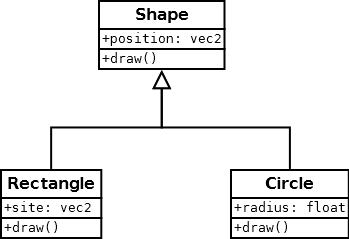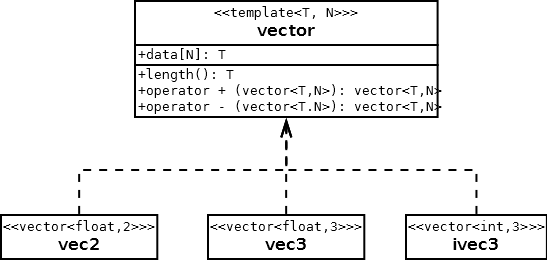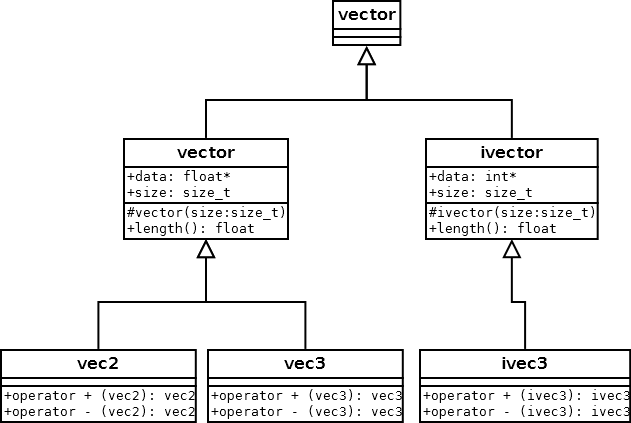Template vs. Inheritance
2014-07-14
I was asked the following question:
Bjarne said "It's usually a mistake to express parametrization of a class and its associated functions with a type using inheritance. It's best done using templates..." but why?? what's wrong with using inheritance??
Oddly enough I never thought about the issue and used templates and inheritance purely on an intuitive level. But now I am forced formulate the difference, where each is applicable and where each falls down.
To show the difference I will use two examples that are clearly at home in their respective implementations.
The first is the well trodden shapes example:

The other is are multidimensional vector as implemented in glm:

What makes the use cases so different?
First you must realize what inheritance means. Classically public inheritance is generally "is a" relationship. (I will ignore protected and private inheritance because that is normally not used and rather a glitch of C++.) The shape example shows that quite well, the cube is a shape and the circle is a shape.
On the other hand the 2d vector is a special case a vector. If there where not templates in C++ the logical implementation would be blatant duplication by implementing different classes, one for each variant.
The important bit from a programming standpoint is, does it make sense to handle different variants through a common base class. In the shape example the bare minimum we want to do to a shape is calling the draw method. With the vectors this is the opposite, vectors of different sizes need to be converted to common size before anything meaningful can be done with them.
To illustrate this point I will invert the implementation.

Although you may come up with a better idea, this rough sketch illustrates the
problem. Since the code needs to accommodate multiple types, bool, int,
unsigned int, float and double to be exact, you can see that there is no
common storage technique. This makes the base class vector basically
meaningless. If I restricted the scalar type to only float there may be some
use to a base class. I could also allow variable size vectors, but then all
variance is in the algorithm and there is only one class. (For N sized vectors
you can see uBLAS's implementation.)
No matter how you spin it the code is clunky and everywhere you need to check for the size. If you want to deduplicate the + operator, for examples you need to write something like:
vector operator + (const vector& a, const vector& b)
{
size_t new_size = max(a.size, b.size);
// new memory is allocated on the heap
vector result(new_size);
for (unsinged int i = 0; i < new_size; i++)
{
// guard against out of bounds access
float ai = i < a.size ? a[i] : 0.0f;
float bi = i < b.size ? b[i] : 0.0f;
result[i] = ai + bi;
}
return result;
}
Although this does not look so bad, the variable vector size requires a allocation on the heap for each operation. In addition, since the vectors may be of different size, each access must be checked and guarded.
Compare that to the version using templates:
template <typename T, size_t N>
vector<T, N> operator + (const vector<T, N>& a, const vector<T, N>& b)
{
vector<T, N> result;
for (unsinged int i = 0; i < N; i++)
{
// you may use v[i] directly, we know i < N
result[i] = a[i] + b[i];
}
return result;
}
Not only is the templated version slightly more concise, it is also way more efficient. The memory is on the stack and since the loop is of constant size, determined at compile time, the compiler may unroll the loop if it thinks it gets a performance benefit. The only minor downturn is the fact that the executable gets larger, since each and every variant is compiled.

Coming up with an idea how to implement the shapes with a template was not trivial. I settled on the basic concept of using traits to encapsulate behaviour into a template environment.
The first problem here is clear, there is no simple way implement the different
attribute sets between the different shapes. One solution could have been that
the traits define a typedef to a struct that contains the attributes and
instantiate this in the body of the Shape class. But I opted in this case in
the least common denominator aproach, having a vec2 with a size. The circle
is simply contained in a virtual rectangle defined by size
(i.e. min(size[0], size[1])).
The other obvious problem now is that you can not have a bunch of shapes and draw that. You can have a bunch of circles and a bunch of rectangles and draw each respectively, but no mixing.
For me the basic rule is as follows:
If you have the same algorithm, but with different types and sized, use templates. If you have multiple types you want to handle though a common interface, use inheritance.